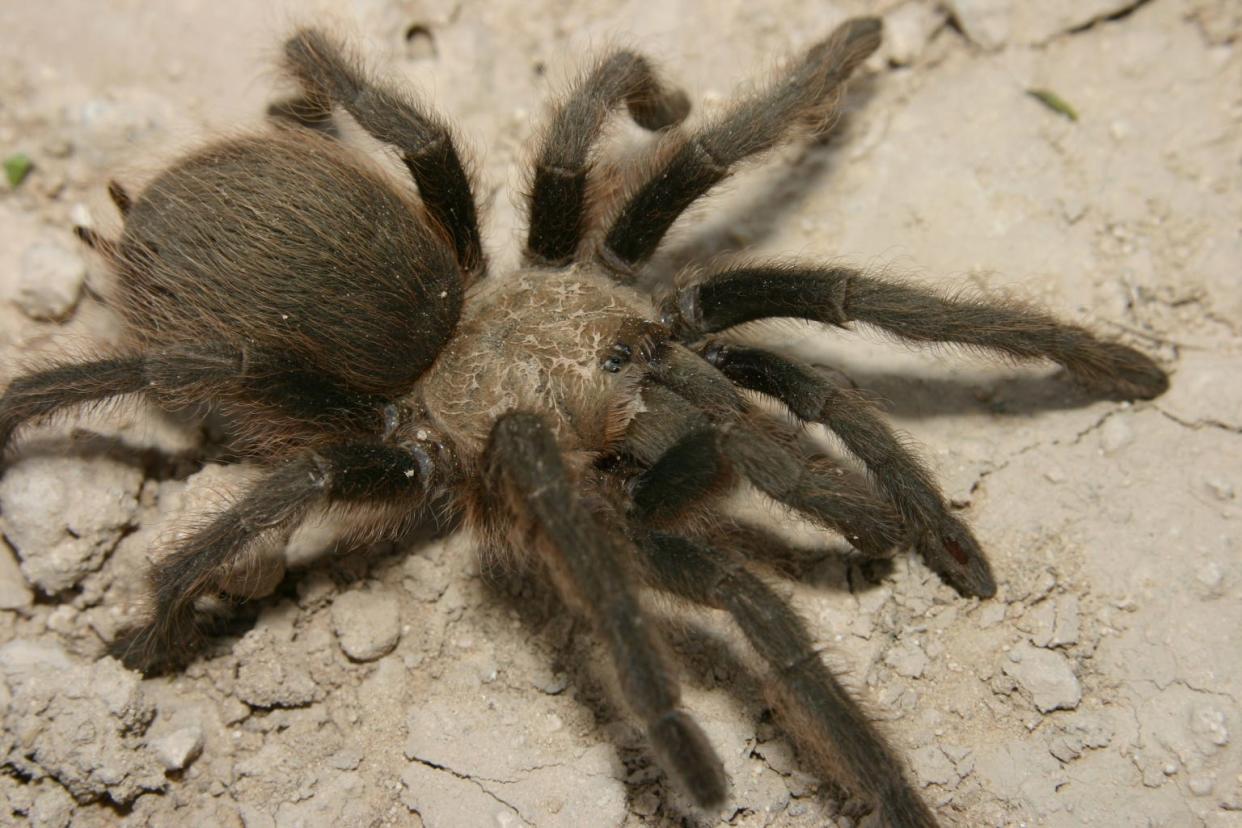Everything to know about the Texas Brown Tarantula

With the onset of “All Hallows Eve” we are bombarded with images that can be described as frightening to downright terrifying on the television, in retails stores, etc. However, as scary as many of these images may be, they pale in comparison to the fear elicited by the largest species of spider in Texas for people who suffer from the fear of spiders, or arachnophobia.
Tarantulas are a large and diverse group of spiders that can be observed throughout the southwestern United States, Mexico, and South America. The most familiar and recognizable species belong to the genus Aphonopelma that is represented in Texas by 14 species, the most commonly observed being Aphonopelma hentzi, the Texas Brown Tarantula.
Texas Brown Tarantulas, like other species of arachnids, have a body that consists of two parts (the cephalothorax and the abdomen) as well as the customary eight legs. As the common name implies, the dorsal coloration is primarily brown, although the intensity of the brown is directly correlated with the age and physical condition of the spider. The abdomen is covered with long, coarse dark brown hairs that are known as urticating hairs. The abdomen is generally one way to differentiate between males and females. The female’s abdomen is as wide or wider than the cephalothorax, giving her an hour-glass or figure-eight shape. The male’s abdomen is generally thinner than the cephalothorax. Tarantulas are among the largest spiders of the New World, and this species is by far our heaviest. Females are slightly larger in size than males, reaching a total body length up to one and one-half inch and a leg span of almost four inches.
Texas Brown Tarantulas can be observed in Texas primarily east of the I-35 corridor and north of the I-10 corridor, although the entirety of the Trans-Pecos is inhabited as well as a smattering of isolated records in east and south Texas. This species can inhabit a myriad of habitats, ranging from the grasslands and cottonfields of the Panhandle to the gravelly, dry soils of the Trans-Pecos, as well as all the habitats in between. The most consistent variable in their habitat selection is the looseness of the substrate as they need to have soil in which to burrow. Most of their lives are spent in this humid underground lair. This is especially true for the females, who allow food to come to them, ambushing their prey as it passes by the entrance to her domain.
Prey items accepted by this species include just about any smaller invertebrate creature, including many harmful and nuisance species, but they have been known to feed on small mammals such as mice as well. Food is eaten in a very odd, if not disturbing, way. The fangs are inserted into the prey item, much like short, hollow straws, and the insides of the food are literally sucked from within. The exoskeleton that remains is discarded after the feeding. This is akin to a person drinking a milkshake. We drink the contents of the cup, (usually with just one straw) but then we throw away the inedible container.
Given their dastardly appearance, most Tarantulas are quite placid. However, they have several means in which they will defend themselves. The first is to try and run for cover. The second is the shedding of the urticating hairs on the abdomen, which can be very itchy and irritating when placed in the eyes, nostrils, or mouth of a would-be predator. The third defense is to raise the forebody to expose the 3/8-inch-long fangs, and the fourth defense is to bite with said fangs. Although Tarantulas, like all spiders, are venomous, the bite is of no long-term consequence as the venom is rather weak.
Due to their relatively passive nature, many Tarantulas are kept in captivity as pets. It has been documented that females can live up to thirty years, and many researchers are of the opinion that they might live longer than that. Males on the other hand generally survive only two to three years.
Every summer, there is a mass movement of Tarantulas that many nature enthusiasts enjoy, and this is when mature males leave their burrows and set out on a quest to find food, as well as to look for love. It is not uncommon to see literally hundreds of males on west Texas country roads as they passively search for these items. It is at this time many Tarantulas can be seen in places such as neighborhoods, backyards, and parks where no others have been seen prior to this time.
Michael Price is owner of Wild About Texas, an educational company that specializes in venomous animal safety training, environmental consultations and ecotourism. Contact him at wildabouttexas@gmail.com.
This article originally appeared on San Angelo Standard-Times: Everything to know about the Texas Brown Tarantula

